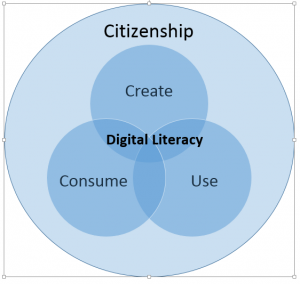Issue, Interest, or Opportunity Identification and Key Word Generator
For my Masters in Education, I focused on creating a Digital Literacy 12 Board/Authority Authorized (BAA) course. After surveying the varying definitions of digital literacy, including the BC Ministry of Education’s draft definition, I synthesized the essential components into the below definition:
Digital literacy is the ability to interact critically, creatively and ethically with text, tools and people in digital contexts. (Stokes-Bennett, 2013)
I further broke this down into the below competencies:
I finished my degree in August 2013 and actually managed to offer and run the course in September (a lot of hoop jumping!). Our semester is just ending now and I want to reflect on what went well and what . . . could go better. More specifically, I want to revise the course to be more inquiry based.
Digital technologies are integral to this course by its very nature (please click here for specific learning outcomes). I have also set up a district hosted WordPress blog as a learning community where all students are contributors. I hope to expand from this to all students having their own blogs for second semester. The challenge has been in needing district hosted blogs in order to not violate the BC Privacy Laws. We are also fortunate enough to have a class set of laptops, 16 iPads, Wi-Fi and, of course, students bring in their own devices.
Digital literacy is going to be a key component of the new curriculum emerging in BC although the Ministry seems unsure of how and where it will fit in. As demonstrated by the BC Ministry of Education’s digital literacy standards (taken verbatim from the ISTE NETS), this is a priority.
I have always found Universal Design for Learning facilitates learners’ engagement and excitement. However, I also believe in the power of inquiry which is where I would like to explore next.
Potential digital technologies that may enrich, enable, or enhance learning (while not violating the BC Privacy Laws), blogging, wikis, YouTube, Prezi, Glogster, etc. I’d love to use Twitter but again run into privacy concerns.
The keywords that I would use to identify elements of this interest would be: inquiry, collaborative inquiry, project based learning, personalized learning, digital literacy, digital citizenship.
A list of possible topics I might need to broaden my understanding of this area of interest would be:
- What is inquiry?
- How does it work? In a classroom? In digital contexts? In blended learning environments?
- What does student inquiry look like?
- How can I effectively facilitate it (especially when my class is offered once a week for 2.5 hours)?
- What are some video and image / collaborative publishing tools hosted on Canadian servers?

Great post. Your writing is quite descriptive and informative. Your images and links added a nice touch to the post. I really appreciated your discussion of the different ways digital literacy overlaps and encompasses so many behaviors. Also, your interest in inquiry based learning sounds like an excellent adaption for your recently launched BAA. I look forward to learning more about your focus and interests in LIBE 477B as we explore these topics in more detail. Great start to the course Devon!
Thanks for this useful resource and image for Digital Literacy. I, too, am interested in inquiry-based learning and how it related to Digital Literacy. At present, I am at a loss as to how to proceed given that many of my students are more familiar with Web 2.0 than am I.